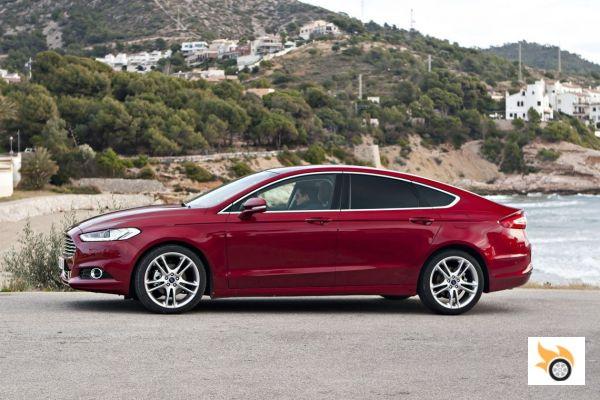
Aware that it has made many of its customers wait and has, in short, lost a lot of ground in the traditional sedan segment (which is no longer as buoyant as it once was), Ford is betting on a wide range of engines, including a hybrid version, full standard equipment and, above all, on a very aggressive pricing and discount policy.
Honda has decided not to give offspring to the Accord and Renault is letting the Laguna die (although its replacement is in the final stages of development). There are still the Peugeot 508, the Opel Insignia and the Volkswagen Passat, to cite three examples, but traditional sedans are disappearing little by little and only a few brands are reluctant to leave this segment, dominated by the 3 German premium. Classic saloons, such as the new Ford Mondeo, are refusing to give up ground to SUVs and crossovers, the public's favourites. And what can the Mondeo offer that a crossover doesn't? Well, something that is increasingly being lost and that at least in the new Mondeo is still very much alive: a driving pleasure far superior to that of any SUV.
Design
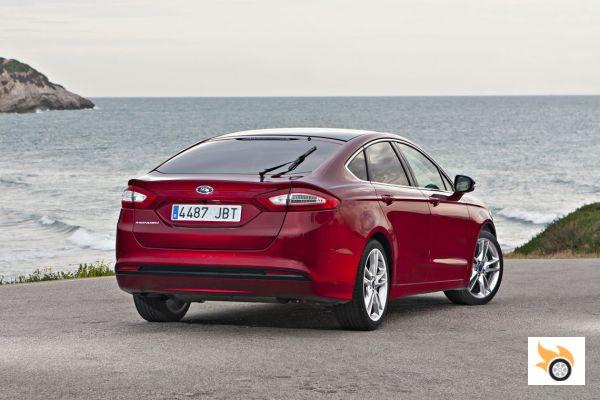
This new Mondeo doesn't recover anything, or almost nothing, from the previous generation and "shares" a lot with the American Ford Fusion. It is 9 cm larger than the previous Mondeo, measuring 4.87 m in length thanks mainly to a longer wheelbase that is now 2,850 mm, something that is particularly noticeable in the rear seats. The new Mondeo's body is also lighter than the previous generation. It weighs 115 kg less, quite a feat, which is due to the use of high-strength steel in 61% of its components and a new aluminium rear axle. Of course, once sound insulation and equipment are added, the weight difference between the two generations is reduced to just 25 kg. An irrelevant value per se in this type of car, but one that demonstrates Ford's desire to limit weight in anticipation of the increased equipment the Mondeo can carry.
The front end is somewhat aggressive and reminds me, to some extent, of the Mustang.
The profile and rear of the new Mondeo are reminiscent of the previous generation, especially the rear and the shape of the rear lights. This unit does not have the famous chrome exhaust tailpipes integrated into the bumper that you see so much in advertisements and in Ford's online configurator. And those beautiful tails are exclusive to the 2.0 TDCi 180 hp and 2.0-liter EcoBoost 240 hp engines, ie, the two top of the range. In our case, we test here the 150 hp 2.0 TDCi, which should be the best-selling of the range.
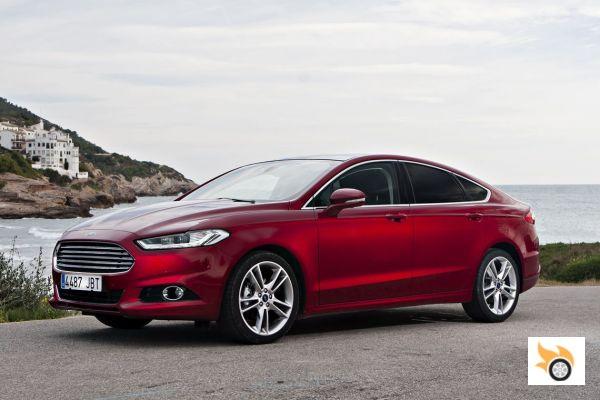
The front, meanwhile, recovers the corporate grille of the brand, which we have already seen in the Fiesta or Focus, for example. I don't know if it's my desire to get my hands on it or if there really is a resemblance, but between the shape of the headlights -thin and giving an aggressive look- and the grille, this Mondeo has a slight resemblance to the Mustang that's not unpleasant.
On board
Inside, the quality of the interior is improving, but some details cool down the first positive impression. The "piano black" finish of some elements scratches easily, while the plastic of the central console seems of inferior quality to the rest of the cabin.
The good thing about this new Mondeo, dashboard-wise, is the streamlined ergonomics provided by the new Sync2 infotainment system. There aren't as many buttons on the centre console as there are in a Boeing and the layout helps to give it that uncluttered feel. And now you can find all the functions at a glance.
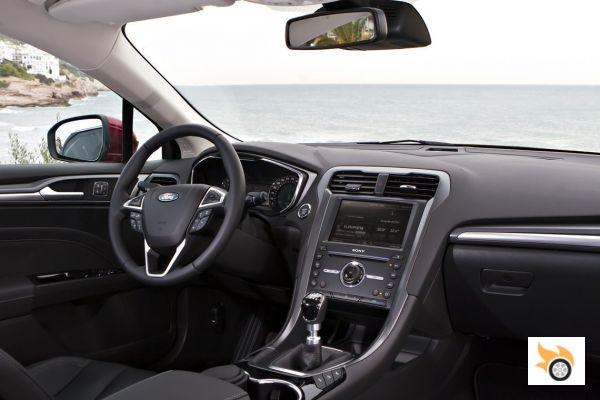
The infotainment system is also much easier to use than in previous generation Fords. The main screen is divided into four zones, each dedicated to a group of functions (audio, navigation, climate control and telephony) and the interface is very intuitive. This is undoubtedly where Ford has made the most remarkable progress.
Inside, the quality progresses, but some details come to cool the first positive impression.
The instrument panel, a mixture of analogue clocks and multimedia screen, is very readable and customisable: you can flood it with information (speed limit sign reading, lane assist, proximity, radio station, range, speed in mph, etc) or limit yourself to the essentials (rev counter, speed, fuel level and engine temperature). Even navigating the on-board computer via the multifunction steering wheel controls is much easier and more intuitive than in any other Ford without Sync2.
The roominess of the new Mondeo has also improved. It could not be otherwise in a car that measures 4.87 m long and with a wheelbase of 2.85 m. In the front, the space in length is superb, the seats are very comfortable -especially those with electric adjustments (with massage function and ventilation as an option)-, but in a car 1.85 m wide the space in width seems to me a little short in the area of the central tunnel and very wide on the side of the doors. Perhaps separating the seats a bit more would improve this sensation.
In the back, the roominess improves and is almost as good as in the front seats. It's true that knee room is larger than in the previous generation, but that's mostly due to the shape of the front seatbacks. Overall, the roominess is good, but in relation to the exterior size of the car, one would expect a bit more. In that respect, the new Passat beats it.
When you open the electric tailgate (Titanium trim), the boot of this fastback saloon looks enormous. However, at 541 litres, it's just 1 litre more than the Mondeo III and a far cry from the new Passat with its 612 litres. That feeling of immensity of the boot comes from its depth: 1.15 m from the sill to the back of the rear seat. Add to that the 23 cm of the bumper and tailgate sill, and you're going to get your trousers dirty and your back crunching to retrieve something at the bottom of the boot.
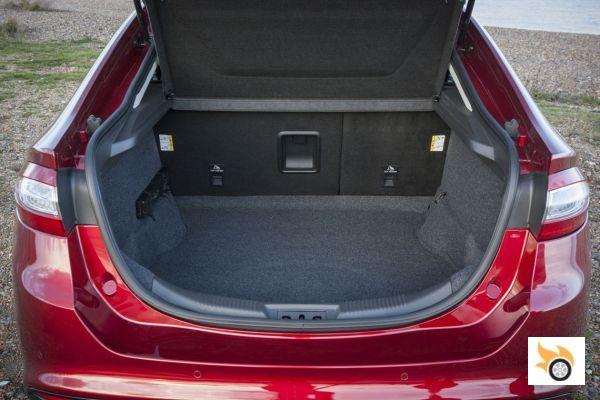
The 25 kg less than the previous generation mentioned at the beginning is, as Ford indicates, in the case of the 1.5 EcoBoost that replaces the 1.6 petrol. In the other versions and in ours, which is packed with optional equipment, that tiny advantage disappears. And that doesn't look good for driving fun. Wrong.
At the wheel
Driving pleasure is one of the advantages that a saloon can offer over an SUV or crossover. Of course, to take advantage of a lower centre of gravity, the chassis has to be tuned accordingly. Fortunately, that's the case with this Mondeo IV. In the first few minutes you already realise its qualities and as soon as you take the corners you can appreciate the goodness of its chassis. The set-up manages to isolate the passengers from the irregularities of the road, offering an excellent level of comfort, while at the same time limiting body movements, both in pitching and rolling.
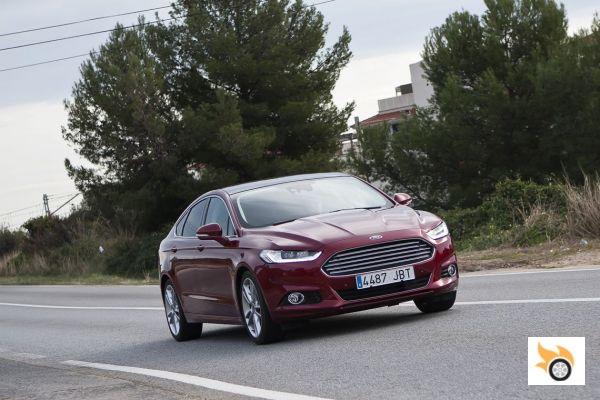
The good isolation is due in part to the new multi-link rear suspension (similar to that used in BMW, for example). It allows for greater comfort while retaining the levels of firmness needed for dynamic cornering. In addition, Ford ensures that the wheel can even move backwards when going over steep obstacles (such as a speed bump), so the kinetic energy is absorbed horizontally and not vertically (shock absorbers) where passengers would notice it much more.
As an option it is possible to choose a piloted damping with three levels: Comfort, Normal and Sport. Although Sport offers a plus in firmness, I am in favour of a passive system - that is, the standard equipment - which already offers an excellent level of comfort and sportiness.
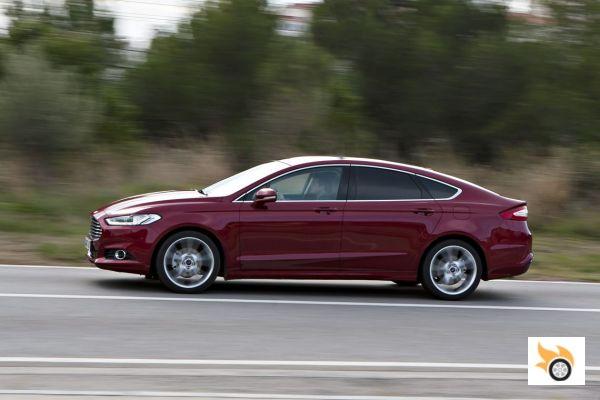
The steering isn't very communicative in normal situations, but it starts to give you feedback when you're approaching the limit and enter a zone where ESP will kick in. Ford managed to get a good electromechanical steering here. I found the front end to be very responsive and precise; cornering in this Mondeo is a pleasure. The nose goes exactly where you tell it to go, the car is planted squarely and the rear end follows it to the millimetre. Only on very poor road surfaces and with an empty boot can the rear end bounce slightly, changing the trajectory, while the front end is unaffected by the wave of torque it has to digest (up to 400 Nm).
The Mondeo has a neutral to agile handling that will satisfy those of us who like to drive.
In any case, it boasts a neutral to agile behaviour that will satisfy those of us who like to drive; it is still far from the level of a BMW 3 Series, but it is much more interesting to drive than an Audi A4. In limit situations it has a marked understeer character, but that's to be expected. No doubt it could have been made more agile, but it would also go against the philosophy of this car, designed primarily for long journeys on fast roads.
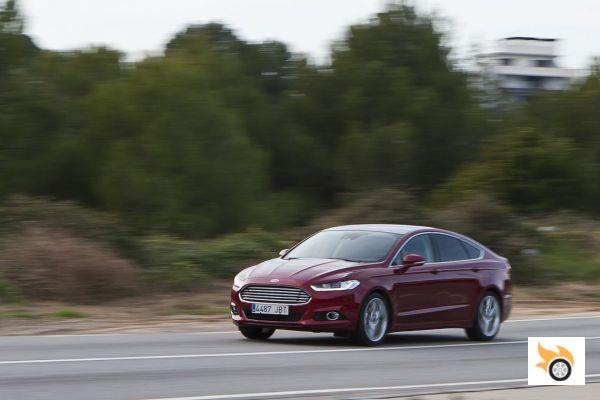
While in twisty areas the torque below 2,000 revs was sometimes lacking, on fast roads this is of secondary importance, as long as you don't have to overtake. The Mondeo's comfort and stability on the motorway are commendable. The soundproofing has improved considerably, and there is even a certain refinement when driving at constant speed.
During acceleration, the diesel engine is noticeable, but not excessively so. Speaking of acceleration, the lack of torque delivery below 2,000 rpm was evident in twisty sections, but also on fast roads, it is noticeable when you want to overtake. This is evidenced by the time of 8.4 seconds to go from 80 to 120 km / h in 4th gear. Honestly, I expected a better time. On motorways it's not a problem, but on two-way roads, the quicker the overtaking, the safer it is. And it's not that the engine is completely lacking in torque below that speed, it's more the fault of overly long gear ratios.
Equipment
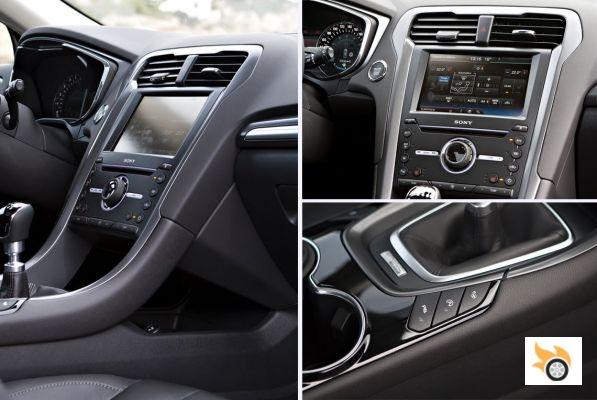
It's not that the new Ford Mondeo is late per se, but that Ford has been absent from the segment for more than two years for all practical purposes. In the meantime, its rivals have been making progress. Moreover, its launch coincides with the arrival of the new Volkswagen Passat, its real rival in the segment. To combat it, Ford is proposing a very aggressive pricing policy (provided the car is financed through Ford) with discounts of 6,000 euros on average. So, the base price for the 150bhp TDCi with Titanium trim is 31,650 euros, but Ford is leaving it at 25,800 euros.
The standard equipment of the Titanium includes, among others, dual zone climate control, cruise control and speed control, light and rain sensor, tire pressure sensor, 17" alloy wheels, front and rear parking sensors, fog lights with chrome surround and dynamic cornering, heated front seats, SYNC 2 system with 8" touch screen and 8-speaker audio, lane departure warning and traffic sign recognition. The options are not as numerous as in other brands, but they are grouped in interesting packages, such as the leather upholstery including electric seats (2,100 euros) or the Hi-Fi Luxury which includes the 8″ TFT SD touchscreen SD navigator with SYNC 2 and Sony radio, Premium Sound System-Audiophile 12 Sony speakers, rear view camera and parking assist system, for 1,800 euros.
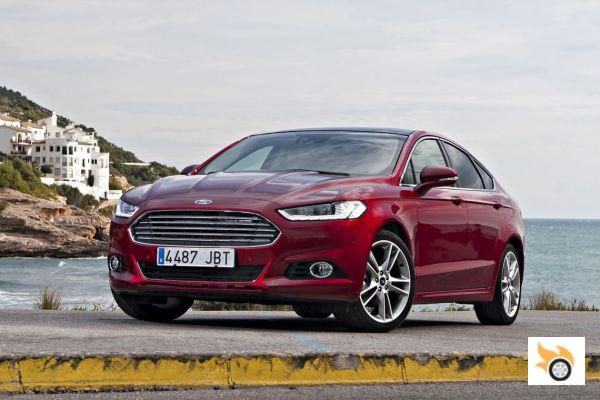
Some might seem very interesting, such as the Tech Premium Package, but perhaps not so much on a day-to-day basis. Somewhat pricey at 2,300 euros, it includes a number of driving aids (Adaptive Cruise Control ACC, pre-collision assistant with pedestrian detection and blind spot detector) and the adaptive suspension CCD and electric and heated seats. The pre-collision assistant is an invaluable aid, no doubt, and in some situations it's evidence of how badly we drive in general. If you listen to the system, the safety distance you have to leave with respect to the car in front of you is such that you will systematically get one or two cars in that gap. You can regulate how permissive the system can be, but you will still get one or two cars in the gap, reducing the distance again. It's not the fault of the system, it's our fault. Although annoying on a day-to-day basis, it is educational and, if we want to, it makes us responsible for driving.
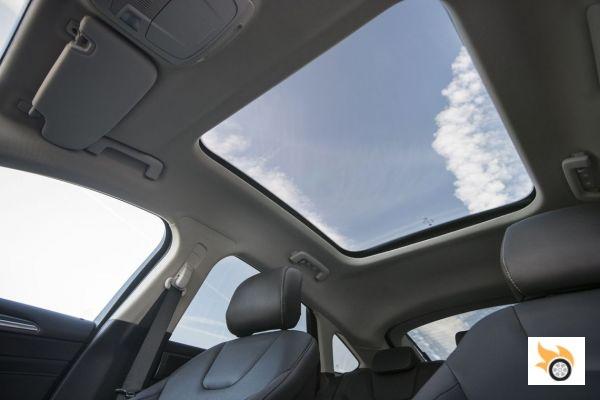
Another system that might seem useful in a 4.80m car is parking assistance. You know, the car detects a space and parks itself. In theory it's ideal. In practice it doesn't work for me: sometimes it detects spaces where there aren't any and sometimes it discards spaces where I did manage to park, albeit with a bit of manoeuvring. Moral of the story, save the assistant and learn to park. At the end of the day, driving is a responsibility and you've been able to live and drive without it until today.
Another noteworthy option is the airbag seat belts. In the event of an accident, they dissipate the kinetic energy in an area of the body 5 times larger than with a conventional belt, thus reducing the size and importance of the contusions caused by the force of the belt on the body. Such bruising is not a problem for a fit adult, but for an elderly person, for example, it's a different story.
Conclusion
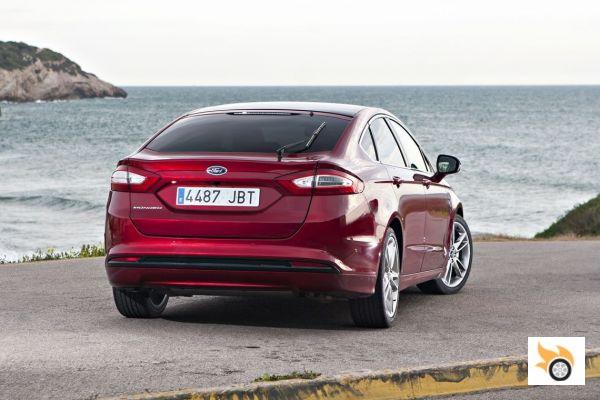
The progress made by the new Mondeo with respect to the previous one places it on the podium of the best D-segment saloons of the generalist brands, ahead of the Opel Insignia, Toyota Avensis or Skoda Superb, for example. And they are models with more than 5 years on the market. Even against a Peugeot 508 (its restyling doesn't change much) the Mondeo is the winner.
Its two main rivals are the Mazda6 and the Volkswagen Passat. The Mazda6 offers some driving pleasure, albeit less than the Mondeo, but with a much more flattering cabin quality. As for the Passat, in Europe it is almost premium and very classically styled.
Finally, there's the question of price. It's clear that the unit we tested (43,550 euros without discount) seems a bit expensive for a Mondeo, even with Ford's discount - it's 37,700 euros. It all comes down to a matter of priorities if we don't take into account the car's financing. If you like a bit of driving, the Mondeo is the car for you. If you prefer a touch of almost premium on-board quality and aesthetic originality, the Mazda6 will be the right choice. The Volkswagen Passat, meanwhile, will remain the car of choice for fleets and anyone who wants a premium without being too noticeable. Finally, if the question of financing the car is important, because from 25,800 euros, the Mondeo TDCi 150 hp Titanium is the most interesting option of all: driving pleasure, equipment, habitability, technological content and price are its trump cards.
Test originally published on autoblog in February 2015.


























